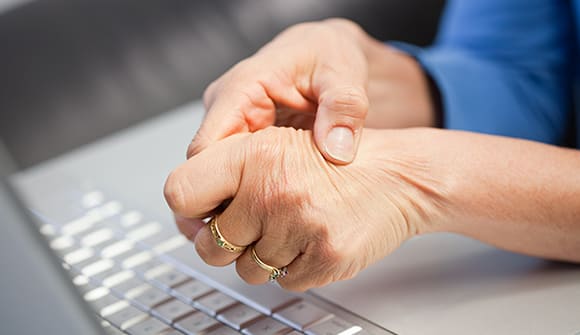Oh, my aching back
Five common causes and how to get relief at home.
Article Date:

Around 65 million adults in the United States have had back pain recently, and 16 million of them have it, well, all the time. In fact, back pain is one of the top reasons people miss work.
While you may feel like you have a bum back, you’re definitely not alone, and your pain is likely caused by something totally normal. The good news is that most back pain can be treated without medication or surgery; you just need a little bit of time and dedication.
Common causes of back pain
Caitlyn O'Sullivan, DPT, a physical therapist with Baptist Rehabilitation, and Brandon Kambach, MD, an orthopedic spine surgeon with Orthopedic Specialists of Jacksonville, generally see patients who have back pain for one of a few reasons. Both agree that many patients’ pain results from damage to the disks in the spine, which provide a cartilage cushion between the vertebrae and help your spine be flexible and absorb shock.
1. Poor posture
“We were not made to sit all day, but the majority of the workforce is at a computer for more than eight hours daily,” O'Sullivan said. “When we sit, the pelvis tends to slide forward over time, which leads to a forward bend in the spine. This places excessive force on the disks in the lower spine. When this force is applied for eight hours a day over many years, the disks and support structures of the lumbar spine break down, causing pain.”
2. Obesity
“Carrying around excessive body weight can lead to many health issues. Obesity puts excessive pressure on the spine which can lead to increased low back pain, and numbness and tingling down the leg,” said O'Sullivan said.
3. Improper lifting technique
"When we bend forward from the spine to pick up an object, we place the spine in an unideal position," O'Sullivan said. "The forward bend compresses the front of the lumbar disks, decreasing cushion between the disk spaces leading to potential backward herniation of the disk. If you then add the force of lifting a heavy object, the movement can damage the disk.”
4. Core weakness
“Your core is a group of several muscles between the spine and pelvis that act as stabilizers,” said Dr. Kambach. “Unlike muscles that push and pull, core muscles create a support structure around the spine, which allows us to walk, bend and twist. Weak core muscles cause an imbalance which forces other parts of the spine to take on more stress.”
5. Injury
“Most injuries of the low back are minor strains, which will typically heal with rest. However, if not treated correctly, even strains can turn into repetitive injuries and chronic problems. Common activities that can result in injury are bending forward at the waist, or lifting and twisting. These activities place significantly higher amounts of stress on the low back,” Dr. Kambach said.
Preventing back pain
These spine specialists agree that once you’ve identified the cause of your back pain, you can make changes to prevent it from coming back or getting worse. There are also ways to ease back pain at home.
- Apply heat to painful areas of the back.
- Rest when injured.
- Use a standing work desk, which helps the spine stay in the ideal alignment.
- Set an alarm to readjust your posture every 20 minutes if you sit while working.
- Exercise regularly to maintain a healthy BMI and keep the spine and surrounding structures healthy.
- When lifting heavy objects, keep your back straight, squat with your feet shoulder-width apart, and bend from the hips and knees instead of your back. Then, lift using your legs.
- Learn proper exercise techniques from a physical therapist and work on strengthening your core.
When to call your doctor
When should you set aside at-home treatments and make an appointment with your doctor? O'Sullivan said to call your primary care physician if you have back pain that lasts more than a few days.
“If it's severe and persists for several days, it's probably best to go to the doctor, who may recommend physical therapy. Physical therapists can help provide specific exercises to improve core strength and lumbar mobility, facilitate safe lifting mechanics and educate on appropriate posture. Physical therapy is usually the first line of defense with back pain,” she said.
If a patient experiences loss of strength in a leg, pain that wakes him or her up at night, inability to stand, or severe pain after a physical trauma, he or she should call the doctor right away.
“Seek more advanced care for your spine if you tried a round of physical therapy and your pain is the same or worse,” said Dr. Kambach. “Also, if the pain radiates into the legs, or you notice numbness, tingling or weakness, you likely need a specialist.”
Do you need help managing back pain?
We can help! To learn more about treatment options for back pain, visit baptistjax.com/back.


